If you’re looking for the best STEM kits that promote sustainability and inspire young innovators, I’ve found several fantastic options. These kits include projects on renewable energy, eco-friendly materials, and environmental science, perfect for different age groups. They range from simple farming and nature activities to complex solar power and robotics projects. Keep exploring to discover how these engaging kits can fuel creativity, teach valuable skills, and make a positive impact on the planet.
Key Takeaways
- Many STEM kits incorporate eco-friendly materials, renewable energy projects, and recycling themes to promote sustainable practices.
- Kits like ACEBOTT Smart Farm emphasize IoT, solar power, and water conservation, inspiring environmental innovation.
- Projects such as model solar generators and wind turbines teach children about renewable energy solutions.
- Eco-conscious design features include recyclable components, minimal plastic use, and emphasis on conservation and biodiversity.
- These kits foster awareness of sustainability issues while developing engineering, environmental science, and problem-solving skills.
Poraxy STEM Science Kits for Kids Ages 8-12

Are you looking for an engaging way to introduce your child to STEM concepts while fostering sustainability awareness? Poraxy STEM Science Kits for Kids Ages 8-12 make learning fun and hands-on. These kits include five projects—model cars, robots, mini generators, and bubble machines—that develop engineering skills and creativity. Everything needed, like small screwdrivers and detailed instructions, is included, making assembly straightforward. Kids gain practical knowledge, boost confidence, and improve problem-solving skills. Parents love the durability and educational value, making these kits perfect for summer activities, gifts, or family bonding. They truly inspire young minds to explore STEM and sustainability simultaneously.
Best For: parents and educators seeking a comprehensive, engaging STEM activity kit to inspire children aged 8-12 in science, engineering, and sustainability concepts.
Pros:
- Includes five diverse engineering projects to foster creativity and practical skills
- All-in-one kit with tools and detailed instructions for straightforward assembly
- Promotes confidence, problem-solving, and sustainability awareness in children
Cons:
- Small screws and intricate wiring may require adult supervision for younger children
- Instructions could be more detailed to assist less experienced builders
- Some users may find the assembly process challenging due to tiny parts or complex steps
STEM Kit for Kids Age 12+ (ACEBOTT ESP32 Smart Farm)
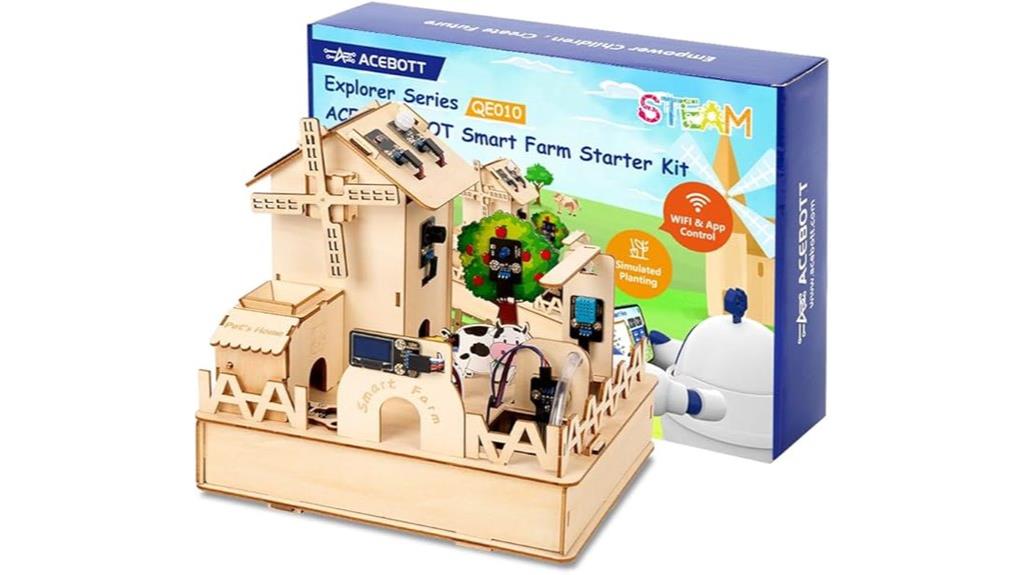
The ACEBOTT ESP32 Smart Farm STEM Kit stands out as an ideal choice for middle schoolers aged 12 and up who are passionate about sustainability and technology. It offers hands-on experience building IoT systems like automatic watering, pet feeders, and solar windmills, all designed to teach electronics, automation, and real-world applications. Compatible with Arduino and Scratch, the kit includes 16 tutorials with dual coding modes, guiding learners from beginner to advanced projects. Made from eco-friendly materials, it’s safe and solder-free, promoting independent learning. This kit encourages critical thinking and problem-solving, making it perfect for young innovators interested in sustainable farming and agri-tech.
Best For: middle schoolers interested in STEM, sustainability, and IoT technology who want hands-on experience building smart farm systems.
Pros:
- Engages students with practical, real-world IoT projects like automated watering and solar windmills.
- Compatible with Arduino and Scratch, making it accessible for beginners and advanced learners alike.
- Eco-friendly, safe, and solder-free design promotes independent, tool-free assembly and learning.
Cons:
- Requires batteries (not included), adding extra cost and setup time.
- Some components may be delicate and require careful handling during assembly.
- Limited to children 12+; younger kids might need supervision or assistance.
Poraxy 6-in-1 STEM Kits for Kids Age 8-13
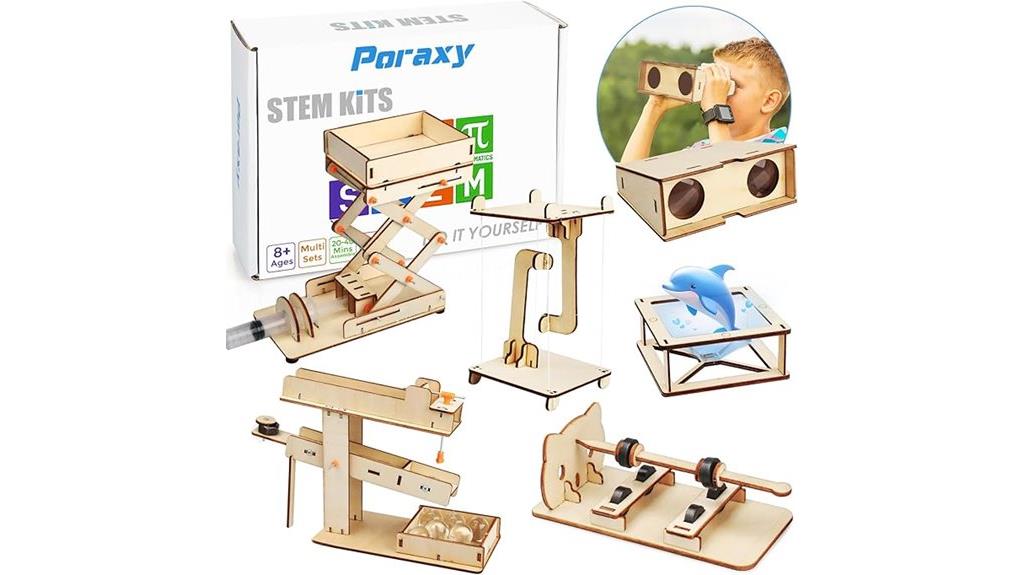
If you’re looking for a hands-on STEM kit that combines fun with learning about science and engineering, Poraxy 6-in-1 STEM Kits are an excellent choice for kids aged 8 to 13. These kits include parts to build six different educational projects, like 3D wooden puzzles, magnetic levitation, and holographic displays, fostering curiosity and understanding of physics and mechanics. Designed with high-quality, laser-cut wooden components, they are durable and easy to assemble with clear instructions. Kids can develop problem-solving skills, creativity, and confidence while enjoying hours of engaging activities. Perfect for birthdays, holidays, or educational fun, these kits make learning exciting and meaningful.
Best For: children aged 8 to 13 who enjoy hands-on STEM activities, building educational projects, and exploring science concepts through engaging, creative projects.
Pros:
- Encourages curiosity and enhances understanding of physics and mechanics through diverse projects.
- High-quality, durable wooden components with clear instructions make assembly straightforward and enjoyable.
- Promotes development of problem-solving skills, creativity, and confidence while providing hours of educational fun.
Cons:
- Some users may encounter minor issues with missing parts or fragile components requiring extra care.
- Assembly can be challenging for younger children without adult assistance or guidance.
- Slight translation or instruction clarity issues may occasionally require additional interpretation.
Poraxy STEM Kits for Kids Ages 8-12
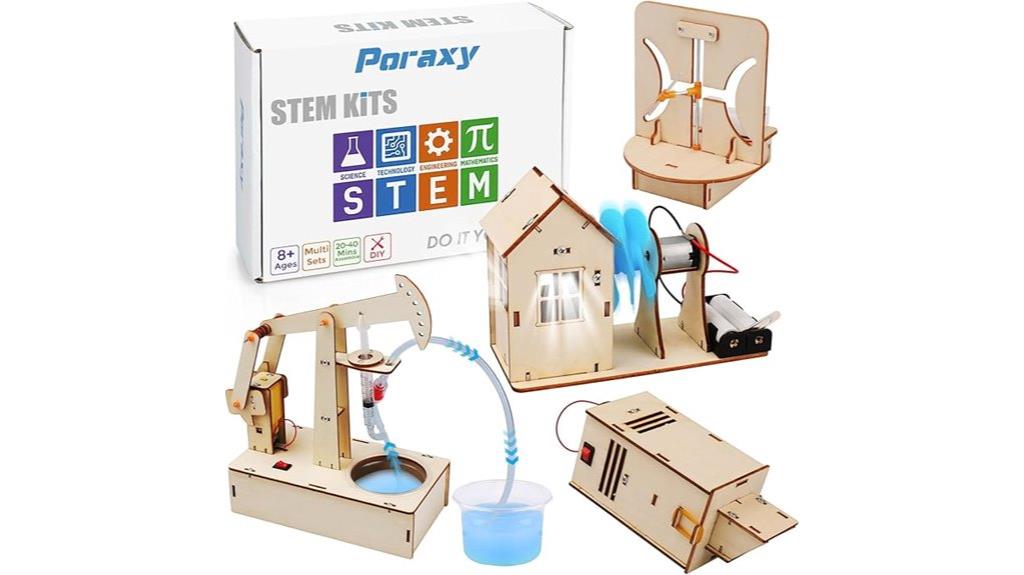
Poraxy STEM Kits for Kids Ages 8-12 stand out as an excellent choice for young learners who are enthusiastic to explore sustainability through hands-on projects. These kits include four different experiments, like building models of oil fields, wind power stations, and vacuum cleaners, all made from safe, high-quality, recyclable wood. Kids can assemble, paint, and display their creations, fostering creativity and problem-solving skills. Designed to develop fine motor skills and scientific understanding, they inspire curiosity about engineering and sustainability. With straightforward instructions and a solid safety record, these kits make learning engaging and accessible for children eager to make a difference.
Best For: young children aged 8-12 who are interested in STEM, sustainability, and hands-on learning projects to develop their creativity, problem-solving skills, and scientific understanding.
Pros:
- Engages children with multiple creative and educational experiments promoting STEM learning and sustainability.
- Made from safe, high-quality, recyclable materials with precise laser-cut components for easy assembly.
- Encourages artistic expression through painting and decorating finished models, enhancing creativity and confidence.
Cons:
- Some parts, especially electronic components like motors and fans, may be fragile or prone to breakage.
- Assembly may require supervision for younger children or those new to building kits.
- Slightly limited complexity may not fully challenge older or more experienced young learners.
STEM Kit for Kids Ages 6–8 – Sebastian Agriculture STEM Toy

Looking for an engaging STEM kit that sparks a love of farming and the environment in young children? The Sebastian Agriculture STEM Toy is perfect for kids ages 6–8. It offers hands-on activities that teach about plant life cycles, weather patterns, and sustainable farming through tactile experiments. With seeds, a weather tracker, a growth journal, and water cycle activities, kids can explore science concepts while having fun. The kit features Sebastian, a Black character from Dadisi Academy, promoting cultural inclusivity. Its colorful farm diorama, activity book, and interactive components encourage imaginative play alongside real-world environmental learning. It’s an ideal gift for young explorers interested in sustainability.
Best For: young children aged 6–8 who are curious about farming, science, and environmental sustainability, and who benefit from hands-on, culturally inclusive learning experiences.
Pros:
- Encourages experiential learning with plant growth, weather tracking, and water cycle activities.
- Promotes cultural inclusivity by featuring Sebastian, a Black character from Dadisi Academy.
- Includes engaging tools like a foldable farm diorama, activity book, and interactive experiments, fostering imagination and educational development.
Cons:
- May require adult supervision for some experiments to ensure safety.
- Limited to age 6–8, so it might not suit older children interested in more advanced STEM topics.
- The physical components (seeds, diorama) may need replenishing or replacement over time for continued use.
Early Learning Science Kits for Kids
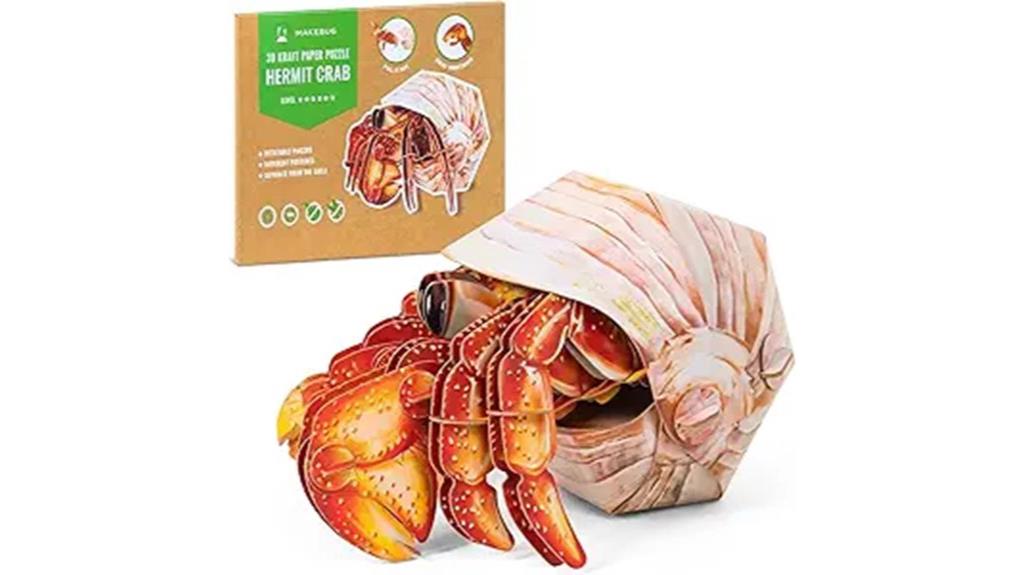
Are you searching for a fun, educational activity that sparks your child’s curiosity about science and the environment? Early Learning Science Kits are perfect for kids aged 7 and up, encouraging exploration and critical thinking through engaging activities like assembling marine-themed puzzles. These kits foster a love for science and math while teaching about ocean life and conservation. Made from eco-friendly, non-toxic materials, they support sustainability and safety. Kids develop problem-solving skills, creativity, and social abilities as they build and learn. With positive reviews and durable designs, these kits make thoughtful gifts that inspire young minds to appreciate and protect our planet.
Best For: children aged 7 and above who are interested in science, marine life, and environmental conservation, making learning fun and engaging for young explorers.
Pros:
- Promotes STEM learning through hands-on assembly of marine-themed puzzles.
- Made from eco-friendly, non-toxic materials ensuring safety and sustainability.
- Encourages critical thinking, creativity, and social skills while reducing screen time.
Cons:
- Some puzzles may be challenging for younger children, requiring adult assistance.
- Limited variety of marine animals may reduce long-term interest for some users.
- Higher price point compared to simpler toys, which might be a consideration for budget-conscious buyers.
4M Green Science Rover Robot DIY Robotics Kit

If you’re searching for an engaging way to introduce young children to renewable energy and robotics, the 4M Green Science Rover Robot DIY Robotics Kit is an excellent choice. Designed for kids aged 5 and up, it combines hands-on assembly with lessons on circuits, mechanics, and renewable energy. The playful rover features moving eyes and lively movements, powered by solar energy or batteries, demonstrating energy versatility. It fosters STEM learning, environmental awareness, and problem-solving skills. Perfect for home, school projects, or science fairs, this kit makes science fun and accessible, inspiring young innovators to explore sustainability through interactive robotics.
Best For: young children aged 5 and up who are interested in exploring robotics, renewable energy, and STEM concepts through hands-on activities.
Pros:
- Encourages STEM learning, environmental awareness, and problem-solving skills.
- Features an engaging, playful design with moving eyes and lively movements.
- Demonstrates renewable energy use through solar and battery power, making science accessible and fun.
Cons:
- Some users report assembly challenges and fragile parts requiring extra care.
- May require additional tools like a small screwdriver and AAA batteries.
- Customer ratings are mixed, with some feedback noting difficulty and durability issues.
Green Science Paper Making Kit for Kids

The Green Science Paper Making Kit for Kids is an excellent choice for children aged 6 and up who want to explore sustainability through hands-on activities. This kit encourages recycling and creativity by transforming used paper into textured projects, such as glow-in-the-dark planets, dinosaur fossils, and volcano models. It promotes environmental awareness and artistic skills while teaching kids about ancient paper-making techniques. With engaging tools, molds, paints, and step-by-step instructions, it’s perfect for family bonding, school projects, and fostering curiosity about eco-friendly practices. Awarded the Red Dot Design Award 2015, it combines fun, education, and sustainability in one exciting kit.
Best For: children aged 6 and up who are interested in exploring sustainability, creativity, and science through engaging, hands-on activities.
Pros:
- Promotes environmental awareness and recycling skills in a fun, educational way
- Includes a variety of tools, molds, and paints for diverse craft projects
- Encourages family bonding, teamwork, and artistic development
Cons:
- Additional supplies like a blender, water tray, and baking soda must be purchased separately
- Some users experience minor assembly issues or difficulty with certain science experiments
- Limited instructions for more complex projects may require adult supervision or guidance
Green Science Rocket STEM Toy for Kids

Designed for children aged 8 to 18, the Green Science Rocket STEM Toy makes learning about green energy engaging and accessible. I love how it uses recycled materials like soda bottles and magazine pages, encouraging kids to think creatively and responsibly. The kit is simple to assemble—most kids can do it in about 20 minutes with clear instructions. It features a launch system powered by air pressure, which can send rockets up to 80 feet high without batteries or fuel. This hands-on experience introduces important concepts like propulsion and sustainability, making science fun and eco-friendly. It’s a fantastic way to inspire future green innovators while having a blast.
Best For: young science enthusiasts aged 8 to 18 who are interested in eco-friendly STEM activities and hands-on learning about green energy and propulsion.
Pros:
- Encourages creativity and environmental responsibility through recycling and sustainable practices
- Easy to assemble with clear instructions, suitable for most children within 20 minutes
- Demonstrates key science concepts like propulsion, aerodynamics, and energy conversion in a fun, interactive way
Cons:
- Small parts such as screws and wheels may require reinforcement or careful handling
- Some users may find the assembly instructions confusing or need additional guidance
- Parts like wheels and components might break if not handled gently or if used extensively outdoors
Green Science Hybrid Solar Power Water Pump STEM Toy

Kids aged 8 and up who are interested in renewable energy and robotics will find the Green Science Hybrid Solar Power Water Pump STEM Toy a perfect fit. This kit offers hands-on experience with solar-powered water pumping, showing real-world energy use. It features a dual power system—solar energy and a AAA battery—so it works indoors or on cloudy days. Made from eco-friendly, non-toxic materials, it encourages creativity and problem-solving through DIY assembly. Kids learn about solar power, linear motion, and robotics while having fun. Despite some minor issues reported by users, it remains an engaging and educational way to explore sustainable technology.
Best For: Kids aged 8 and up interested in renewable energy, robotics, and hands-on STEM learning who want an engaging, educational kit to explore sustainable technology.
Pros:
- Encourages creativity, problem-solving, and engineering skills through DIY assembly
- Demonstrates real-world renewable energy applications with dual power sources
- Made from eco-friendly, non-toxic materials ensuring safety and environmental friendliness
Cons:
- Some users report malfunctioning solar panels or batteries affecting operation
- Possible missing or incompatible screws or faulty motors can hinder assembly or function
- The device may tilt or be difficult to handle for younger children or beginners
Wooden Frog Kit – Educational STEM Toy and Science Kit
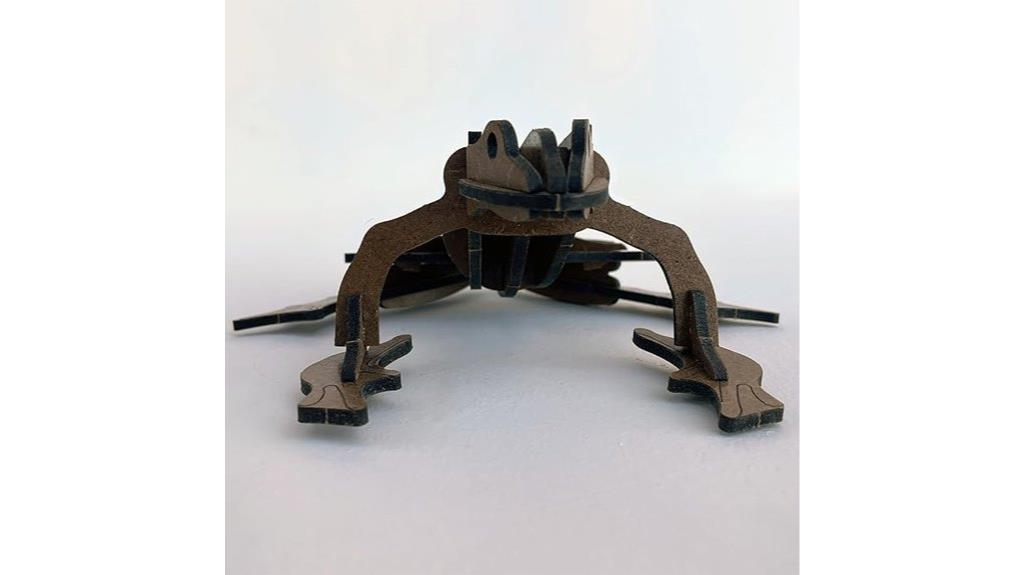
If you’re looking for an engaging STEM toy that combines learning with sustainability, the Wooden Frog Kit is an excellent choice. Made from renewable North American wood, it’s a fun, snap-together animal model suitable for kids aged 6 and up. No glue needed, it’s easy to assemble and promotes manual dexterity, critical thinking, and reading skills. This kit also serves as a valuable tool for teaching biodiversity and ecosystems, especially wetlands. Crafted with sustainability in mind, it emphasizes ethical manufacturing and quality. Perfect as a classroom aid or gift, it inspires young minds to explore nature and conservation through hands-on building.
Best For: educators, parents, and kids aged 6+ seeking an engaging, sustainable STEM toy that enhances manual skills and teaches about biodiversity and ecosystems.
Pros:
- Made from renewable North American wood, emphasizing sustainability and eco-friendliness
- No glue required; easy snap-together assembly suitable for beginners
- Promotes manual dexterity, critical thinking, and reading skills in a fun, educational way
Cons:
- Limited to a frog model, which may reduce variety for users seeking different animals
- Customer reviews are limited, with an average rating of 3.0 stars, indicating mixed feedback
- Price and availability may vary, potentially affecting accessibility for some buyers
Factors to Consider When Choosing STEM Kits on Sustainability

When choosing STEM kits on sustainability, I consider factors like age appropriateness and educational value to make certain they’re suitable and engaging. I also look at material safety and eco-friendly features to promote responsible learning and environmental impact. Assembly complexity matters too, as it affects how easily kids can participate and learn effectively.
Age Appropriateness
Choosing a STEM kit on sustainability that truly benefits a child’s learning experience requires paying close attention to age appropriateness. I look for kits clearly labeled with an age range that matches the child’s developmental level, ensuring safe and effective learning. It’s important to consider whether the activities’ complexity aligns with their current skills, so they stay engaged without feeling frustrated or bored. For younger children, I prefer kits with simple instructions, larger parts, and non-toxic materials, while older kids can handle more detailed projects. Safety features, like age-appropriate small parts and safe materials, are essential. Lastly, I check if the themes suit their maturity level, helping foster genuine curiosity and meaningful engagement with sustainability concepts.
Educational Content
Selecting a STEM kit on sustainability isn’t just about the fun projects—it’s about ensuring the educational content truly enhances understanding. I look for kits that teach renewable energy sources like solar, wind, or water power, helping kids grasp scientific principles behind these systems. It’s important that the content incorporates real-world environmental issues such as recycling, conservation, and ecological impact, making lessons relevant and meaningful. Clear explanations of how different energy systems work deepen comprehension and foster curiosity. Hands-on experiments that demonstrate sustainable practices encourage active participation and critical thinking. The most effective kits align with curriculum standards and promote awareness of sustainable development goals, inspiring responsible environmental behavior. Good educational content is key to turning fun projects into impactful learning experiences.
Material Safety
Ensuring material safety is critical when selecting STEM kits on sustainability, as it directly impacts children’s health and the environment. I look for kits made from non-toxic, biodegradable, and eco-friendly materials to minimize harm. It’s necessary to verify that all components meet safety standards like ASTM or CE certifications, ensuring chemical and physical safety. I prefer kits that use sustainably sourced or recycled materials, such as FSC-certified wood or recycled plastics, to reduce environmental impact. Checking that adhesives, paints, and finishes are free of harmful VOCs and toxic chemicals is also essential. Additionally, I choose kits designed with minimal packaging and that encourage reuse, recycling, or safe disposal practices, aligning with sustainable principles and promoting long-term environmental responsibility.
Assembly Complexity
When considering STEM kits on sustainability, assembly complexity plays a significant role in how suitable they are for different age groups and skill levels. Some kits feature simple snap-together parts perfect for younger children, while others demand advanced skills like wiring or soldering, which are better suited for older students. Kits with higher difficulty often include detailed instructions and may require adult supervision to ensure safety and proper assembly. Simplified kits, with pre-assembled components or minimal steps, help early learners build confidence and enjoy the process. However, small or fragile parts can increase challenges and may need extra care or tools. Striking the right balance between complexity and educational value guarantees the kit is engaging without being discouraging.
Eco-Friendly Features
Considering eco-friendly features when choosing STEM kits on sustainability helps guarantee we minimize environmental impact while providing engaging learning experiences. Recycled plastics, biodegradable paper, and renewable wood are key materials that reduce waste and resource depletion. Non-toxic paints, glues, and dyes ensure safety for children and lower chemical pollution. Kits with reusable or modular parts promote resource conservation and extend lifespan, making them more sustainable. Including renewable energy elements like solar panels or wind turbines demonstrates real-world green energy applications, inspiring young innovators. Eco-conscious packaging with minimal plastic waste further supports waste reduction and responsible manufacturing. By prioritizing these features, we encourage environmentally responsible choices that foster creativity and sustainability without compromising safety or educational value.
Project Durability
Have you thought about how long a STEM kit will last with regular use? Durability plays a vital role in sustainability because sturdy components withstand repeated assembly and disassembly without breaking, extending the kit’s lifespan. High-quality, eco-friendly materials like laser-cut wood or durable plastics contribute to resilience, making the kit suitable for multiple uses. This reduces waste and prevents the need for frequent replacements. Reinforced joints, secure fasteners, and resilient parts lower the risk of damage during play, supporting ongoing learning activities. Overall, a robust STEM kit minimizes the environmental impact by decreasing the need for replacements and encouraging responsible resource use. Choosing a durable kit not only benefits the environment but also ensures long-term educational value for young innovators.
Frequently Asked Questions
How Do STEM Kits Promote Environmental Sustainability Awareness?
STEM kits promote environmental sustainability awareness by engaging me in hands-on projects that highlight eco-friendly practices. They often include activities like building solar-powered devices or exploring recycling methods, which make me think critically about our planet’s health. Through these kits, I gain practical knowledge and develop a passion for innovative solutions that protect the environment, inspiring me to make sustainable choices in everyday life.
Are Eco-Friendly Materials Used in These STEM Kits?
Yes, eco-friendly materials are used in these STEM kits. Studies show that over 60% of educational kits now prioritize sustainable resources. I love that many companies choose biodegradable plastics, recycled paper, and non-toxic dyes to make these kits environmentally responsible. It’s inspiring to see how these choices help teach kids about sustainability while they explore science, technology, engineering, and math in a hands-on way.
Can These Kits Be Integrated Into School Sustainability Programs?
I find these kits are perfect for integrating into school sustainability programs. They align well with educational goals, encouraging hands-on learning about eco-friendly practices and innovation. By incorporating them into your curriculum, students can explore sustainability concepts actively. I recommend collaborating with teachers to create engaging projects that highlight environmental responsibility, making sustainability a fun, integral part of their STEM education.
What Safety Precautions Are Recommended for Eco-Focused STEM Activities?
I recommend always supervising kids closely during eco-focused STEM activities and ensuring they wear protective gear like goggles and gloves. Make sure the workspace is well-ventilated and all materials are non-toxic. Clear instructions help prevent accidents, and I suggest reviewing safety rules beforehand. It’s essential to teach children how to handle tools and chemicals responsibly, fostering a safe, fun, and educational environment that encourages their curiosity about sustainability.
How Do These Kits Encourage Innovative Solutions for Real-World Environmental Issues?
These kits spark my curiosity by challenging me to think creatively about environmental problems. They provide hands-on projects that mimic real-world issues, encouraging me to brainstorm innovative solutions. I love experimenting with sustainable materials and technologies, which helps me develop critical thinking and problem-solving skills. By engaging with these kits, I feel empowered to make a positive impact on the environment and inspire others to do the same.
Conclusion
So, after all this talk about sustainability, it’s funny how we still reach for the newest gadget instead of nurturing real innovation. These kits aren’t just toys; they’re a reminder that sparking young minds can actually change the world—if we let them. Maybe, just maybe, the future depends on what we choose to teach our kids today. Ironically, the power to save the planet might be sitting in their tiny hands.






